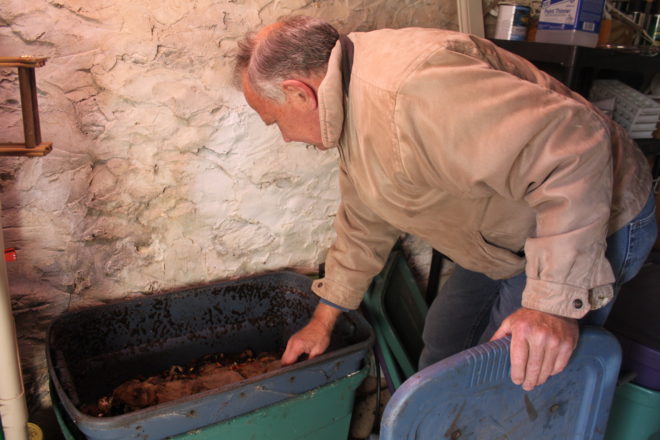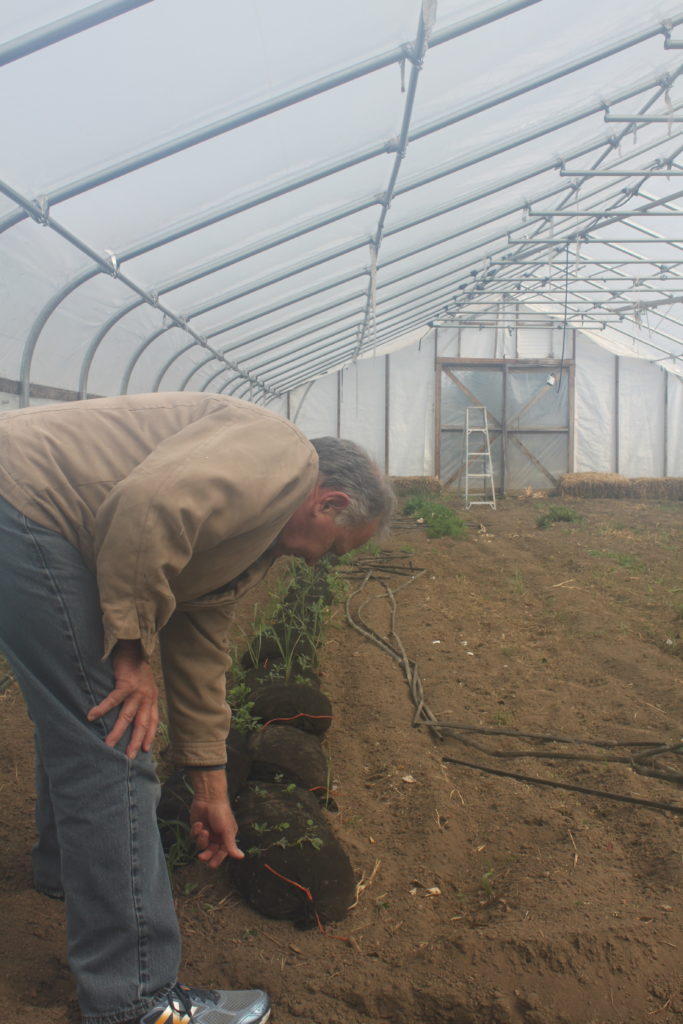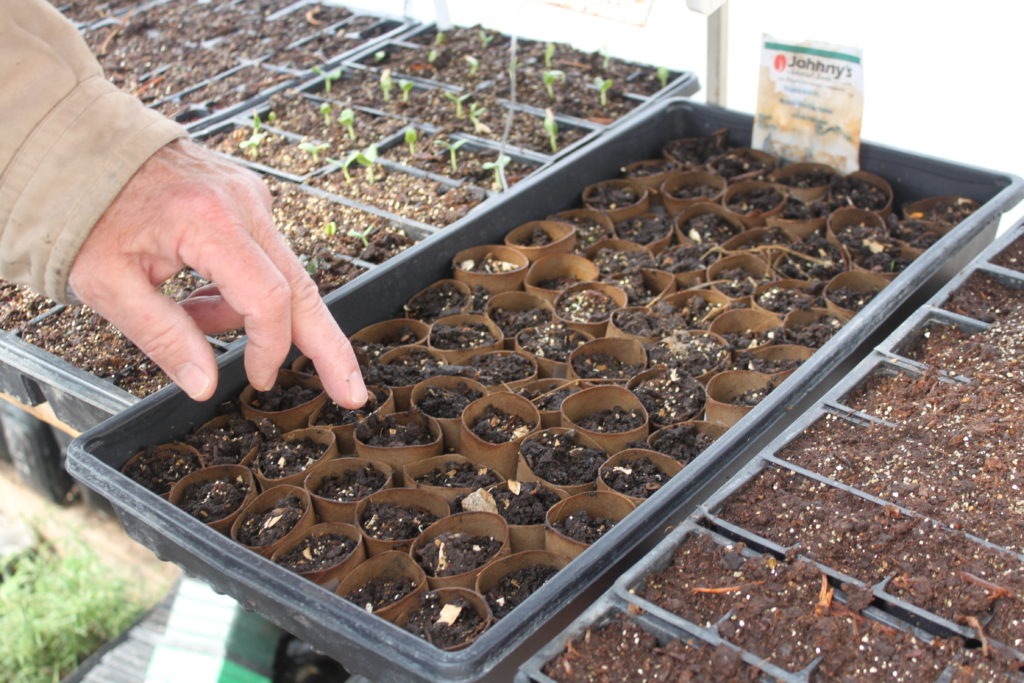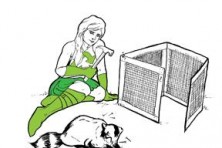Ultimate Recycling: Composting Has a Home in Door County
- Share
- Tweet
- Pin
- Share

Once a week, Myles Dannhausen, Sr. hauls home two five-gallon buckets of food scraps from the continental breakfast at his hotel, the Bay Point Inn in Egg Harbor.
“You’ve got your melon skins and pineapple skins, a lot of bulk,” said Dannhausen. “Then there’s the coffee and the egg shells. You need the eggshells for the worms. They need the calcium to thrive.”
He reaches in a big blue bin in the cellar of his home, still cold from the winter weather saturating the stone walls, and pulls out some worms that have been dining in the cellar’s darkness.
Most would think he is a mad scientist, performing an earthy alchemy in the quiet of his Egg Harbor home. But really, Dannhausen just likes to eat fresh and local vegetables.
Composting is the process of breaking down organic materials such as food scraps, grass clippings, fallen leaves and paper into rich soil to use in a garden. Anything that was alive will naturally decompose. People like Dannhausen have just found a way to speed up that natural process.
“That’s a pile we got two years ago,” said Dannhausen, pointing to a five-foot-high brown mass at the back of his yard. Local farmers drop off some of their unusable yard waste to Dannhausen, where he can turn it into soil for his garden. “We let that rot down. I just put a little skid steer load in here and, get a little rain, it will wash down in a few weeks. For a garden this size, that’s a drop in the bucket.”
In the high tunnel greenhouse, Dannhausen has already started planting while watching other plants sprout up after wintering over.
“I’ve got my tomatoes strung and of course we want to try to get the tomatoes to grow up and trim the bottoms. We’re a little behind this year,” said Dannhausen, wishing he would have started a month before. An operation like Dannhausen’s takes some serious preparation, but composting doesn’t have to be so complicated.
How to compost at home
There are two types of waste that thrive in a compost pile: brown waste and green waste.
Brown waste includes dry materials such as dry leaves, grass clippings, wood shavings and most other yard waste you would find outside. Green waste includes food scraps, eggshells, used coffee and tea, and anything else from your kitchen besides meat and bones.

The high tunnel greenhouse allows Dannhausen to extend his gardening season in the early spring and late fall. Photo by Jackson Parr.
Your compost pit can be as simple as a pile in the backyard or a garbage can. A savvier composter might build a garden box with two-by-fours.
After you have some waste and a place to put it, pile in an equal amount of brown and green waste. Layer these types of waste so that brown and green materials are in contact with each other.
After that, it’s simply a waiting game. Keep the compost moist if it doesn’t rain and use a pitchfork or shovel to turn over the pile of compost every few weeks.
The bigger your pile and the more frequently you add waste, the longer it will take to become rich soil. The process typically takes three months in warmer weather and the process speeds up if you turn over your compost more frequently.
When you do find a mixture of deep black soil with an earthy smell, layer it on your garden and till it into the soil.
It’s been about 10 years since Dannhausen first began tossing fallen leaves on his garden. Since then, he has developed a vermicompost system, or composting using worms to further digest the waste and quicken the decomposition of wet materials.
Dannhausen dumps some of his green waste from the hotel into big blue bins and the worms get to work. The liquid is drained, combined with water and used in the garden. The solids are separated and used in the garden as well.
Dannhausen said his goal is “getting to the point where you can use the product so that you can eat healthy food all year round.”
“I made a stir fry last night out of mostly our own product, how often can you do that and still get a balance of good food?”
But it takes time and a certain desire to play with garbage. During the summer, Dannhausen takes part in the farmers’ market circuit, which takes three full working days to manage. That doesn’t include the daily tasks around the garden.
But Dannhausen thinks there is still plenty of room for Door County residents and business owners to embrace composting.
“People don’t want to spend the time to do it,” said Dannhausen. “We throw away half of the produce we produce right here because you get bruised tomatoes and diseased stuff and everything you get gets old.”
For anyone else, including a restaurant’s food scraps and a grocery store’s expired produce, that compostable material goes to a landfill, where it breaks down in a different way.
In a landfill, without the aeration provided by your pitchfork, the waste decomposes anaerobically, or without oxygen. This process releases methane, a gas that’s more destructive to the atmosphere than carbon dioxide.

“These are toilet paper rolls cut in half with bunching onions. You can get half a dozen bunching onions in one of these cells and you plant that right in the garden and when you’re ready to harvest it, you just pull the whole cell off,” said Myles Dannhausen, Sr. Photo by Jackson Parr.
Joie Powell, who spends her time between gardening at About Thyme Farm and as a commercial painter, has started filling up a composting room.
“I’m not a very traditional gardener,” said Powell. “I work closely with Bearded Heart…I take their compost. I take a lot of coffee grounds so that adds a lot of fertility to my compost. It’s an easy way to garden in a concentrated way.”
About Thyme Farm also collects the kitchen scraps from Björklunden in Baileys Harbor, has worked with Cornerstone Pub and uses the decomposed fresh produce that Powell feeds to the chickens on the farm.
Powell admits that the challenge for restaurants is separating the meat and bones from the rest of the food scraps.
While Dannhausen has a larger operation than most, he still believes the goal is simply to support yourself and produce as little waste as possible.
“It’s a constant challenge,” said Dannhausen. “You sit there and think, from a bird’s eye, doing a thousand acres and maybe you’re off the wrong track. But when you get down to it, if you can produce enough for yourself and make a little money selling to other people, you’re ahead of the game.”

